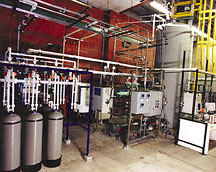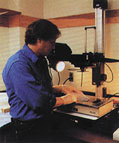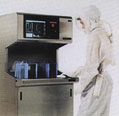

Center for Microcontamination Control (CMC)
The University of Arizona (lead)
A National Science Foundation Industry/University Cooperative Research Center since 1984
Partner Institutions:
- Northeastern University
- Rensselaer Polytechnic Institute
Reduction of defects and improving yield in semiconductor manufacturing is key to U.S. competitiveness

|
Mission Statement and Rationale
Contamination by inhomogeneous and homogeneous impurities accounts for the majority of defects encountered in processing semiconductor devices fabricated with sub-micrometer dimensions. The CMC focuses on all forms of contamination--solid, liquid, gaseous, and biological, as well as on-yield enhancement methods.
Inhomogeneous contamination (inorganic or biological) in a process chamber, gas stream, or liquid chemical can affect many of the processing steps required to fabricate a semiconductor device. Homogeneous contamination in gases and liquids may cause deposits on a surface that result in performance problems in semiconductor devices. Contamination may also affect a chemical reaction involved in depositing, etching, or polishing a film.
The CMC's research goals are to--
- Conduct interdisciplinary research on microcontamination control and reduction that is of interest to the semiconductor manufacturing community
- Transfer both competitive and pre-competitive technology to its members
- Provide an environment for cooperative research between industry and academia
- Educate students in the fundamental disciplines necessary to advance semiconductor manufacturing
- Increase fundamental knowledge in areas related to microcontamination control.

|
Research Program
CMC's activities involve several departments at the University of Arizona: electrical and computer engineering, chemical and environmental engineering, materials science and engineering, and optical sciences.
In 1998 the Center expanded to add a research site at Rensselaer Polytechnic Institute (RPI), and in 2001, further expanded to add a research site at Northeastern University. Researchers from RPI's Electrical and Computer Engineering, Materials Science, and Chemical Engineering Departments, along with those from Northeastern's Mechanical and Manufacturing Engineering, Physics, and Electrical and Computer Engineering Departments, participate in and manage Center projects.
CMC's contributions include the following--
- Developing laser-absorption metrology to measure low-level contamination in gases
- Developing metrology tools to measure low- and extremely low-level biocontamination in and on surfaces exposed to ultrapure water
- Developing tools for measuring particles on rough surfaces of wafers
- Modeling particle behavior in flowing gas streams
- Strengthening the fundamental understanding of liquid-particle-surface reactions in and near complex wafer surfaces
- Understanding particle-surface cleaning mechanisms.

|
Special Center Activities
The Center manages a four-university, five-center research project in biological contamination of ultrapure water. This project involves researchers at University of Arizona, The University at Buffalo, New Jersey Institute of Technology, and the Questor Centre at Queen's University of Belfast, Northern Ireland. This is a three-year project with well over $1 million in funding from the NSF, the Northern Ireland government, as well as U.S. and N.I. industrial center members.
A CMC researcher has designed a metrology tool, which will detect on-line, and in-situ, the formation of the first mono-molecular protein layer. This protein layer must form prior to the arrival of any bacteria. It will be useful to determine cleaning and sanitizing schedules for ultrapure water systems as well as commercial reverse osmosis systems. These same tools can be used to evaluate new materials for their suitability in demanding applications.
Using conclusions from a project initially funded by the membership, QRP, Inc. sponsored additional research that resulted in the development of an electrostatic discharge detector, referred to as the "static bug." CMC then transferred the technology of electrostatic discharge detection to QRP as the exclusive licensee to manufacture the detector. The static bug, which looks like a dual inline pin package, is being designed as a low-cost item to monitor microchips that have been damaged in shipping.
A CMC researcher has developed a radically new method using the DNA polymerase chain reaction (PCR) to characterize the bacterial content of ultrapure water. The goal of this project is to create a method which is both on-line and radically more sensitive than current technology. Current tests require 3-5 days and are not accurate. DNA-PCR can detect, in a few hours, one bacterium equivalent in 100 liters of water.
Computer software developed by the CMC calculates the scattered light from a particle on a layered semiconductor wafer. This computer program was used by KLA-Tencor to aid customers in calibrating counters. It was also used to design a new generation of highly efficient surface scanners -- for example, the Surfscan 6400 series. This instrument can detect a 0.2 micrometer particle on the rough backside of a silicon wafer.
Some of the Center's other accomplishments in the area of technology transfer include--
- Transferring the technology of carbon dioxide snow cleaning to an equipment manufacturer
- Transferring laser technology to a startup firm for use in defect control. From this original work, the startup firm now has 15 U.S. patents and 30 employees
- Translating papers from Japanese to English, and distributing them to CMC members.

|
The Center's educational program has provided a cross-disciplinary research environment with myriad opportunities for students and faculty from across the campus to across the Atlantic. Numerous doctoral and masters students have completed their degree programs with support from CMC funding.
The Center has supported short courses in--
- Contamination and defect control
- Vacuum technology
- Basic reverse osmosis water treatment
- Advanced reverse osmosis water treatment.
The Center's facilities include the following--
- Garment and equipment test tower: a Class 1 facility for use in evaluating gowns, wearing apparel, and equipment--one of four such facilities in the United States, and one of two in a U.S. university (UA)
- Class 10 cleanroom (240 sq. ft.) containing surface scanning equipment, vertical furnace for growing ultrathin oxides, and wafer cleaning systems (UA)
- Access to the Microelectronics Laboratory, containing teaching and research space including an atmospheric pressure mass spectrometer, numerous air and liquid particle counters, two IPEC-Speedfam 372 CMP metal machine and one IPEC-Speedfam 776 four-head CMP machine (UA)
- Access to the CIEEM Microfabrication Laboratory, which contains all eight-inch wafer processing equipment and wafer metrology for CMOS fabrication and defect analysis (RPI)
- Access to 5500 sq. ft. cleanroom with complete microfabrication and micromachining facilities (Northeastern).
Center Headquarters
Center for Microcontamination Control
Department of Electrical and Computer Engineering
University of Arizona
Tucson, AZ 85721-0104
Tel (520) 621-3397 * Fax (520) 621-8881
Homepage: www.ece.arizona.edu/~cmc/
Center Co-Director: John F. O'Hanlon
ohanlon@ece.arizona.edu
Center Co-Director: Kenneth Rose
(518) 276-2891 * rosek@rpi.edu
Center Co-Director: Ahmed Busnaina
(617) 373-2992 * busnaina@coe.neu.edu
Center Evaluator: David A. Tansik
(520) 621-1710 * dtansik@bpa.arizona.edu
NSF 01-168hh